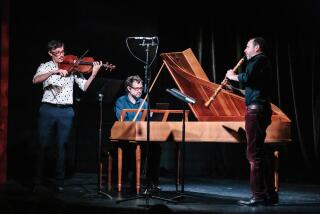A Handel academy’s expressive teachers
- Share via
The articulate, personable British harpsichordist Richard Egarr has appeared many times under the aegis of the Da Camera Society of Mount St. Mary’s College’s Chamber Music in Historic Sites series. He has performed by himself, in tandem with violinist Andrew Manze and as guest director of the Academy of Ancient Music -- always, as per the series’ custom, in a different locale.
Sunday afternoon, Egarr came back with the academy, but this time as its newly anointed music director. Christopher Hogwood, the equally articulate, personable founder of this pioneering London early-music band, stepped down in September after 33 years in charge (he will continue as emeritus director), leaving it in familiar, tried-and-true hands.
As Egarr completes his first season at the helm, his main focus is on the 250th anniversary of Handel’s death in 2009. A new, fizzing recording of the Concerti Grossi, Opus 3, Egarr’s first as the academy’s leader, just came out on Harmonia Mundi, with the organ concertos and chamber music due next. Handel is also what the academy’s current American tour is mostly about, along with a couple of side trips into Telemann.
With Egarr directing from the harpsichord Sunday, the academy’s playing in Nos. 1 and 2 of the Concerto Grossi, Opus 3, contained a lot of rambunctious vigor, oomph and expressive possibilities realized within the limits of period instruments. The Handel Organ Concerto, Opus 4, No. 6, lacked an organ, but Egarr made do by playing the part on the harpsichord, giving portions of the piece an intimate, music-box ambience.
A short suite from Handel’s “Water Music” was juxtaposed with Telemann’s obscure, much more explicitly pictorial “Water Music,” whose tunes are almost as catchy as Handel’s. The other Telemann work was the Concerto in E minor for recorder and flute, whose most arresting quirk was the droning, Eastern European folk-flavored finale.
The locale du jour was the Crystal Ballroom of the Millennium Biltmore Hotel, where the ornately over-the-top interior probably had a lot to do with the evenly balanced, just-reverberant-enough sound. A staggering amount of detail from Egarr’s harpsichord, the Baroque cellos and the theorbo (a lute with an absurdly long neck) could be heard -- and savored.
More to Read
The biggest entertainment stories
Get our big stories about Hollywood, film, television, music, arts, culture and more right in your inbox as soon as they publish.
You may occasionally receive promotional content from the Los Angeles Times.










